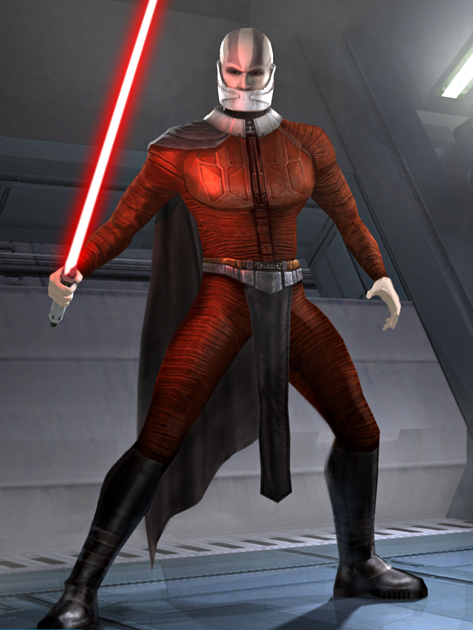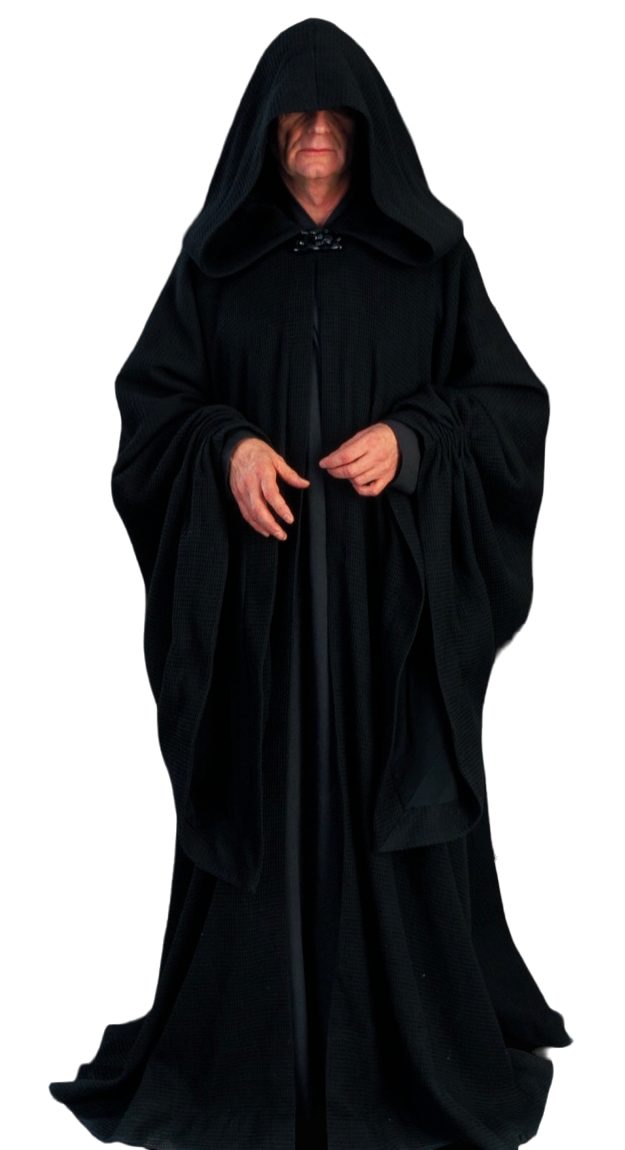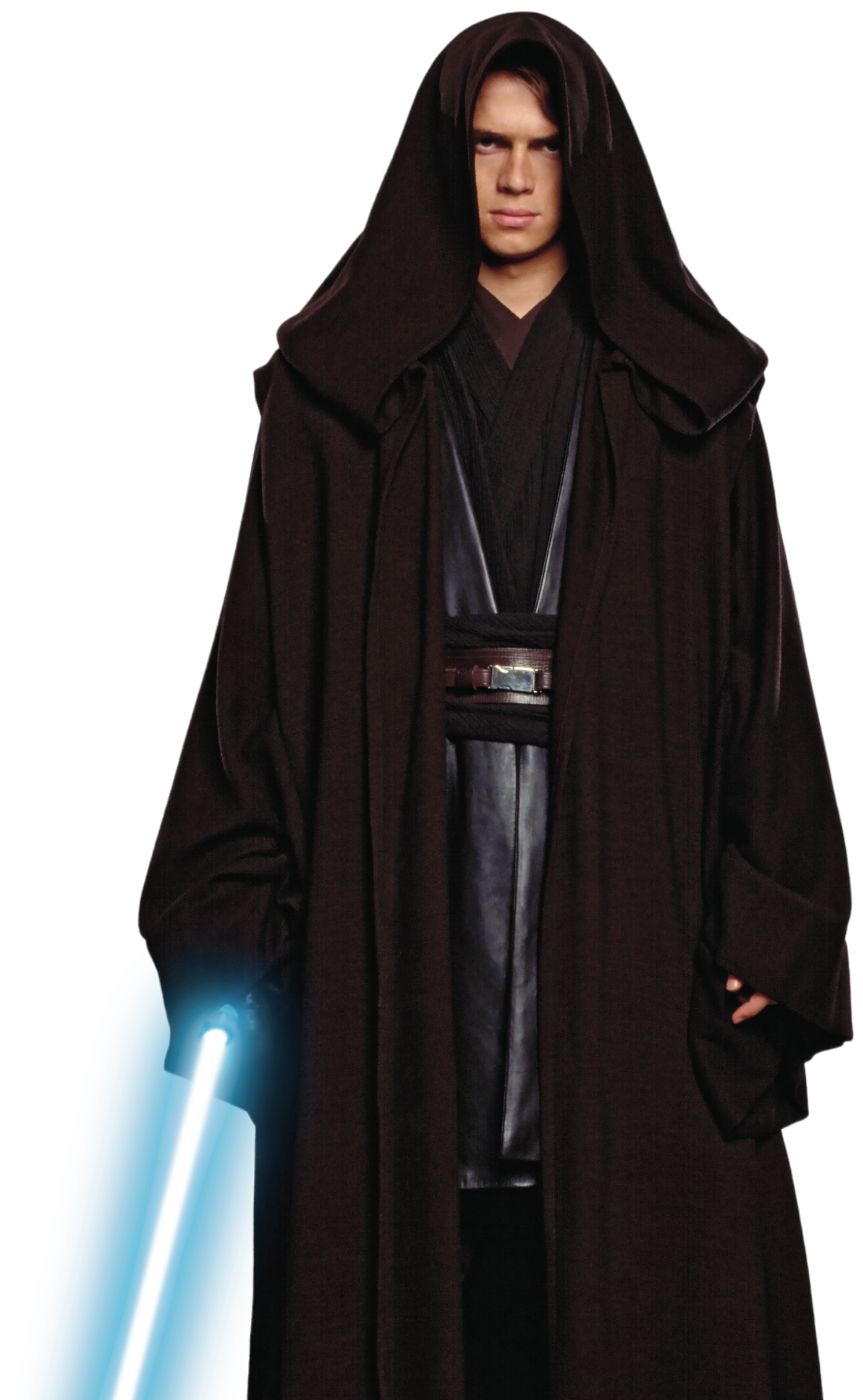Sith apparel was the term given to the general attire of members of the Sith Order in all its forms, with most Sith wearing Sith robes Unlike the Jedi who did not believe in material possession, the position of Sith Lord was highly individualized and the personal attire of each Dark Lord reflected this.
Although similar to the clothing and armor worn by the Jedi Knights of the Galactic Republic, Sith apparel was in fact much more personalized to the wearer than its Jedi counterparts; for many Sith, their armor and robes were an integral part of their identity. For users of the dark side, their clothing and armor usually involved some measure of physical protection, such as traditional armor plates, cortosis, or even self-contained life support systems. Many Sith were most easily recognized by their distinctive garb and often used this to further intimidate or impress their foes and allies alike.

The personalized Sith armor worn by Naga Sadow
The first Sith Lords were fallen Jedi who enslaved the Sith, a species hailing from the Stygian Caldera. This resulted in a mixed-race population with mixed cultural traits. The apparel of the Sith Order combined inspirations from both the Jedi, the guardians of justice and freedom in the Galactic Republic, and the Sith.
Unlike their Jedi forefathers, the Sith Lords enjoyed flaunting riches and outstanding signs of their wealth. They adopted a fastuous fashion full of bright colors such as green, light red or purple, with ornamented parts of golden armor. They also favored extravagant headdresses, war helmets and capes accented with eccentric necklines. Naga Sadow and Ludo Kressh were good examples of this. Most Sith Lords would feel pleasure and a sensation of power through the jealousy and greed their material possession aroused among their peers. This attitude was still present amongst the Sith millennia later—Master Qordis was known to wear only the finest silks and most expensive jewelry, and he possessed luxurious apartments on Korriban.
Robes worn by Sith were known as Sith robes. Many Sith robes were Force-imbued in the making, so that they could be used to enhance or assist one's ability to channel the dark side of the Force and call upon more strength or wisdom than they naturally would. Some of those artifacts were still intact and usable at the time of the Old Sith Wars, such as Aleema Keto's or Crado's robes, and the dreaded Helm of Dathka Graush. Around 5000 BBY, some of the Massassi warriors who accompanied Naga Sadow on Yavin 4 were also known to sport specialized combat gear that allowed them maximum agility in dense jungle environments.

Warb Null built his own set of Sith armor.
The Sith Lords of the Old Empire each wore personalized battle armor designed to strike fear into their enemies. Each Sith Lord tended to have their unique set of armor, though standard models were known to exist. The Sith armors traditionally consisted of metal plates worn over dark robes, and were usually covered in sharp spines to be used as weapons. Some time prior to 3998 BBY, the young Onderonian metallurgist Shas Dovos made his own suit of Sith armor out of steel plates, following the instruction of an ancient book. Dovos later merged with his armor, turning him into a new and powerful being known as Warb Null.
Millennia later, Darth Vader's heavy suit would follow this tradition of donning intimidating and fearsome-looking protective coverings. If the latter followed closely the making process of the ancient armors, it's quite possible they were made through the use of Sith Alchemy, in order to augment the user's physical strength and vitality.
After the Dark Lords Exar Kun and Ulic Qel-Droma established their Brotherhood of the Sith, the first order to their new students was the Sith uprising, in which the apprentices were commanded to strike down their Jedi masters. As such, very few of them had the chance to change their Jedi garments which led to a yet less uniformed Sith Order.
Kun went on with the tradition of the battle armor, as he himself wore one. Sith warriors wore robes designed with a hood which could conceal the wearer's face, keeping them from being identified. Some Sith Robes also came fitted with basic armor made of cortosis. These robes shared some similar fashion features with the Jedi Adventure Robe and the Ceremonial Jedi Robes.

Darth Malak wore a skintight crimson bodysuit that showed off his powerful physique.
At the time where Revan founded his new empire, the Sith likely chose to get more practical robes. The technology itself had known fundamental improvements in the previous decades, and gave a more austere and high-tech look to the whole Galaxy. This is probably why individuals such as Darth Bandon, Darth Malak or even Revan himself wore such unadorned sets of clothes. Darth Revan himself owned a special set of armored robes, including a full helmet of Mandalorian design. The many renegade Dark Jedi who joined Revan simply clung to Jedi garment style, adapted to the dark shades of their new allegiance. The Sith Empire also had huge numbers of minions at its command, including the Sith assault troopers and the Sith Assassins, whose outfits were highly specialized.
In the aftermath of the Mandalorian War, the Republic officers who served under Revan turned and joined the new Sith Empire. They replaced their red and yellow uniforms with azure blue/gray jumpsuits, with higher ranking officers wearing caps. This uniform also came to be worn by the trainees at the Sith Academy.
Sometime after the Great War, a Sith robe was a popular choice of garment for Sith serving the Sith Empire and the Sith Emperor during the Cold War between the Sith and the Republic. It was heavier than what Sith usually wore before and after the events of the Great War and the Cold War. The Jedi developed a similar garment which was equipped by their military forces. They also had a special type of gauntlet, called Warrior's gloves, that they wore during the Cold War.
Throughout the New Sith Wars, the style of the Sith apparel evolved into a more sober form, though it still had a touch of the old elaborate fashion of the ancient Sith Lords. Brighter colors were left behind in favor of different shades of black, dark purple and gray. The Sith would generally wear black capes with cuirasses and multi-pouched belts with buckles featuring symbols similar to Sith tattoos. Lord Skere Kaan and Darth Bane themselves were often seen dressed that way, and Bane even wore an armored pauldron and a vambrace to protect his left arm. Darth Bane later wore biological armor made from hard-shelled orbalisks which, through a symbiotic relationship, increased his Force abilities.

Darth Sidious wore dark, concealing Sith robes.
The Sith Lords that came after the establishment of the Rule of Two were in hiding and generally favored simpler black garments. Their concealing black robes made them appear as if they were creatures of the night.
Darth Sidious favored monk-like robes made of harsh zeyd-cloth. His prefered robe was black, with a raised waffle pattern on it and long sleeves that reached to just below the wrists. This gave the illusion, by the time of 4 ABY, that Palpatine, the alter-ego of Sidious, had merely been a simple man. Along with his black robe, Palpatine possessed several sets of Sith robes. One set was similar to his favored black robes but was made of a burgandy material. Another was made in a burgundy velvet-like fabric, ornamented with Sith symbols. Palpatine publicly wore it in front of the Senate when he addressed his Declaration of a New Order. Indeed, he knew nobody in the rotunda would recognize the origin of these clothes, and he estimated the time of hiding had come to an end for the Sith. Another was a gray robe with a large hood, a black velvet capelet and puffed sleeves as seen when he battled Yoda. When the reborn Sidious went on a trip to Korriban in 11 ABY, he adorned a shorter, more practical variant of his well-known black cape, complete with capelet and a long, straight walking stick.
Sith apprentices wore special training gear during their training to become Sith Lords. An example of such training gear was worn by Darth Maul, and consisted of an uniquely tailored vest. Once Maul acquired the rank of Sith Lord, he wore the black garb of the Sith Order. In a more elaborate fashion than the standard zeyd-cloth cloaks, Darth Maul wore black robes and loose-fitting desert-like garb, and a collared coat belted at the waist. The very large hood would drape down the back while the sleeves were elongated and almost touched the ground. Where the sleeves attached to the main body of the robe, two slits were cut, through which Maul could put his arms.

Though in his original Jedi attire, Darth Vader's robes share a similarity to the hooded cloaks of the Sith.
Darth Tyranus, Sidious' second apprentice, retained the traditional garb of the Counts of Serenno. It consisted of a dark brown double-breasted Vjun tunic, a pair of horse-riding pants and an armorweave cape—the shape of which would enlarge the Count's silhouette. He also wore black boots made of rare rancor leather, reaching just below the knees.
Though Asajj Ventress wasn't a Sith per se, she wore "the trappings of the Sith", as Dooku himself noted. Her gear consisted of high-collared tight-fitting black and white shirt and leggings under a flowing black skirt. The skirt was easily removable by simply tucking the sash away.
When Darth Vader needed to be put in the suit that he would later be known for, Darth Sidious insisted on creating an intimidating look and completed the design with a cape and tabard reminiscent of the traditional Sith garb. Vader himself provided his Secret Apprentice with an Imperial uniform that he mended himself many times over his lifetime. Starkiller's training gear was both simple and versatile seeing as it survived numerous training sessions and volatile missions. Starkiller used variants of his basic gear, such as the homemade Heavy training gear which provided protection in toxic and polluted environments. Another was the Light training gear which was suited for use in humid environments.
Sith of Darth Krayt's Order wore armor of various designs. Darth Krayt himself wore an imposing form of armor created by the Yuuzhan Vong that was designed to instill fear into the hearts of his enemies. Darth Wyyrlok wore a set of combat armor over his robes, while Darth Nihl wore a strange set of armor designed to intimidate enemies.
Sith robes production design
As George Lucas envisioned the Sith as the dark counterpart of the Jedi, their robes were mainly designed as black versions of the Jedi apparel. The under-robes for the costume of Palpatine as an Emperor were in fact a Japanese kimono of black raw silk, as revealed in Star Wars: The Magic of Myth book. Ben Kenobi's inner robes were also made of the same material, but in a beige version. Darth Maul's attire was sewn from a hand woven fabric called Indian Homespun which had been dyed black by costume designer Trisha Biggar.
Tales of the Jedi design
Though the timespan covered by the Tales of the Jedi stories kind of fits "Star Wars' Middle Age", the style of the costumes rather reflects Antiquity. As for the Sith, they seem to be widely inspired by ancient Babylonian or Egyptian fashion; for example, Naga Sadow's and Darth Andeddu's headdress are quite similar to Pharaonic deshret and khepresh crowns. Also, rather than be limited to dark colors, the robes of these ancient Sith were quite vibrantly colored, extremely opulent.
- Soulcalibur IV
- Star Wars: The Magic of Myth
- Star Wars: Episode I The Visual Dictionary
- Star Wars: Power of the Jedi
- Star Wars: Attack of the Clones: The Visual Dictionary
- The New Essential Guide to Weapons and Technology
- Star Wars: Revenge of the Sith: The Visual Dictionary